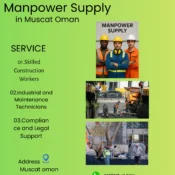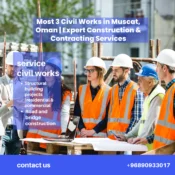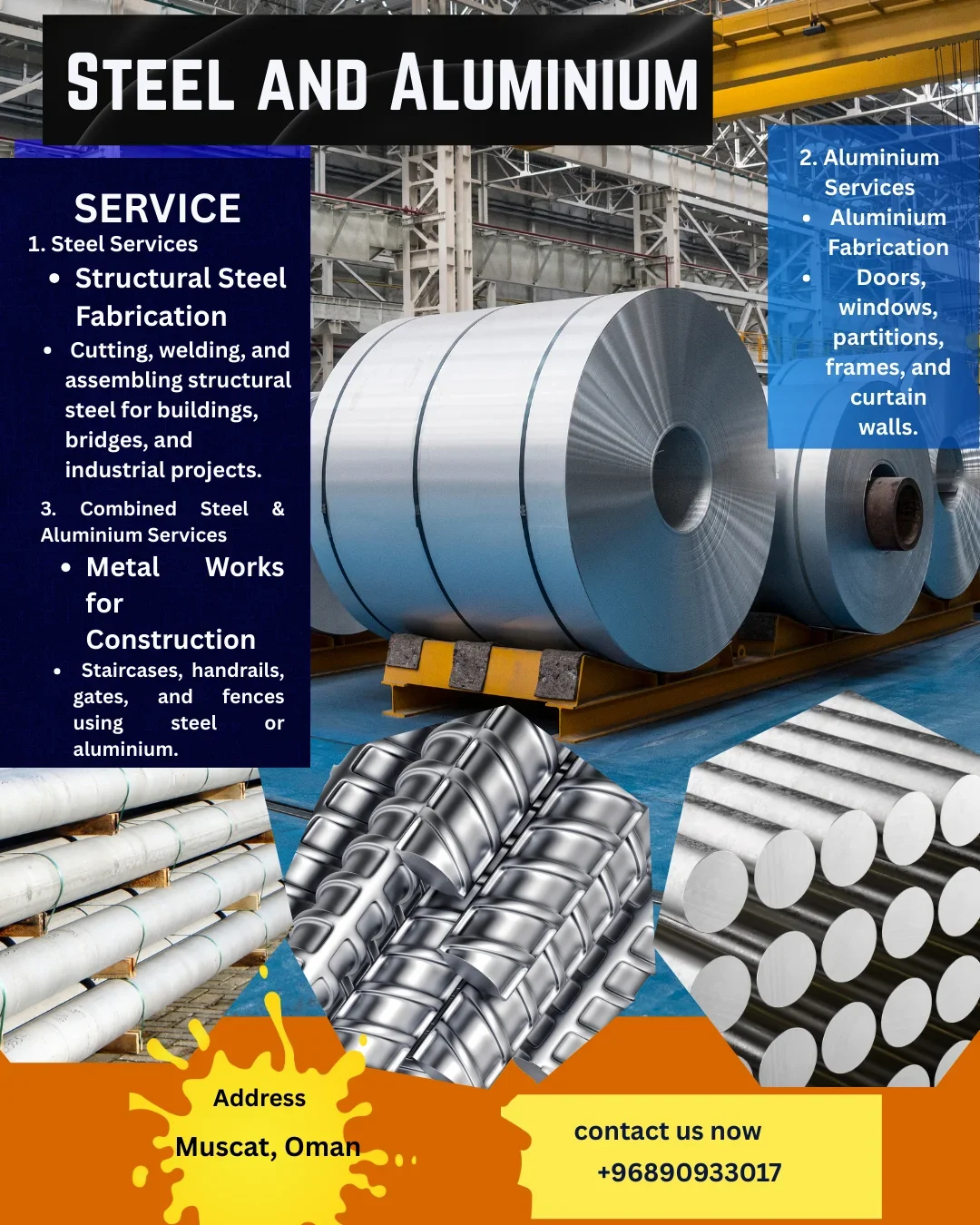
Steel and Aluminium Fabrication in Oman Powering Muscat’s Growth
Steel and aluminium construction in Oman quickly drives the development of industry and infrastructure in Muscat. From modern skyscrapers to large construction projects, these essential metals build the backbone of the country’s development. With advanced construction techniques, efficient craftsmanship, and a rich local market, Oman has become a centre for high-quality steel and aluminium solutions. In this article, we find out how the production in Muscat strengthens the industry, meets international standards, and shapes the future of the Sultanate and the engineering fields.
Table of Contents
The Importance of Steel and Aluminium in Oman’s Development
Steel and aluminium play an important role in the economic development of Oman and the development of infrastructure. These metals are important for the construction of modern buildings, bridges, ports and industrial functions that support the ambitious vision of the Sultanate 2040 schemes. Steel provides unmatched power and durability for heavy structural applications, while aluminium provides mild versatility, corrosion resistance and aesthetic appeal. Together, they form the basis for construction and energy fields in Oman. By investing in advanced steel and aluminium production, Muscat and other cities secure infrastructure in the long term, promoting local industries and Oman as a competitive player in the global market.
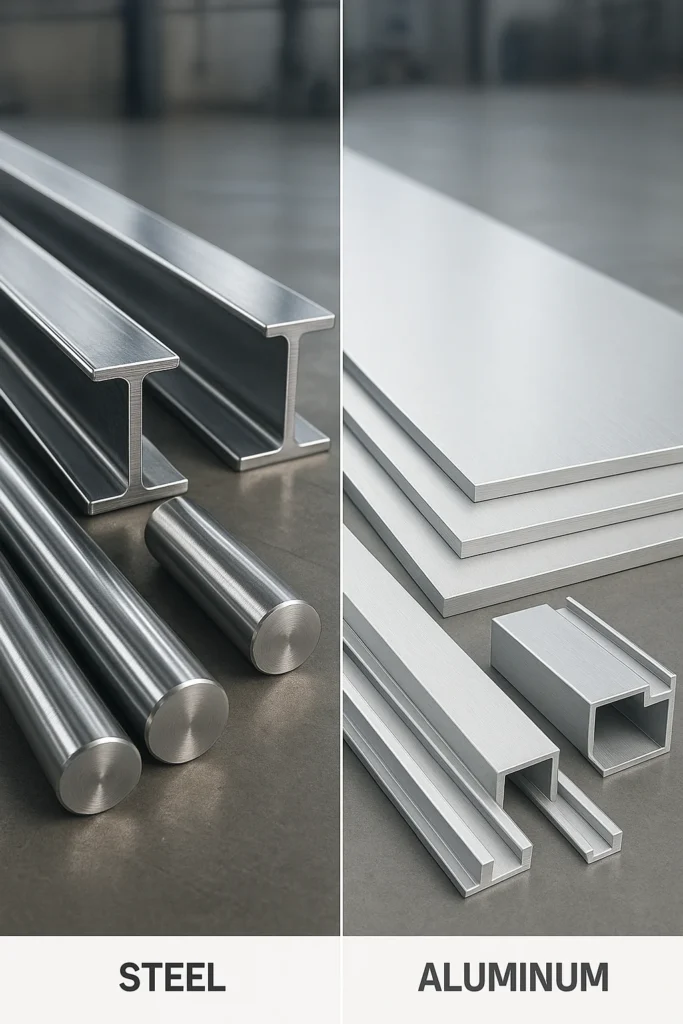
Role in Infrastructure Projects
Steel and aluminium fabrication plays a pivotal role in Oman’s large-scale infrastructure projects, serving as the backbone for bridges, highways, airports, ports, and public buildings. Steel’s unmatched strength ensures the stability and longevity of heavy structural frameworks, while aluminium’s lightweight and corrosion-resistant nature makes it ideal for cladding, roofing, and architectural elements. In Muscat, ongoing developments such as modern transport networks, commercial hubs, and energy facilities rely heavily on these metals to meet international safety and design standards. By integrating advanced fabrication techniques, Oman ensures its infrastructure projects are durable, cost-efficient, and built to withstand the country’s diverse climatic conditions.
Contribution to Economic Growth
The fabrication industry significantly contributes to Oman’s economic growth by supporting key sectors such as construction, manufacturing, energy, and transportation. In Muscat, this industry creates thousands of direct and indirect jobs, boosts local supply chains, and attracts both domestic and foreign investment. By reducing reliance on imported materials and enhancing local production capabilities, Oman strengthens its economic resilience and competitiveness in regional markets. Furthermore, the export of high-quality fabricated products opens new revenue streams, positioning the country as a trusted supplier within the GCC and beyond. This steady industrial growth aligns closely with Oman’s Vision 2040, driving sustainable economic diversification.
“In industry, steel gives us power and aluminium gives us possibilities.” — Charles Martin Hall, Inventor of the Aluminium Extraction Process
The Growing Demand for Steel and Aluminium in Muscat
.
Demand for steel and aluminium in Muscat has increased in recent years, inspired by the city’s rapid urban extension, industrial projects and infrastructure development. When Oman invests heavily in commercial buildings and improves residential complexes, ports, and energy functions, it increases the requirement for high-quality, durable metals. Steel is a favourite alternative for construction and structural power in industrial framing, while aluminium is widely used for its mild properties, corrosion resistance, and modern aesthetic appeal. As an important economic centre with its position in Muscat, the steel and aluminium industry is expected to experience stable growth and provide new opportunities for suppliers, manufacturers and investors
“The strength of steel and the versatility of aluminium together make them the backbone of infrastructure and industry.” — Elon Musk, Entrepreneur & Industrialist
Urban Expansion and Construction
Urban expansion in Muscat has been a major driver of demand for steel and aluminium, as the city continues to grow with new residential, commercial, and mixed-use developments. From high-rise towers and shopping malls to housing complexes and public facilities, these metals provide the strength, durability, and modern aesthetic required for large-scale construction projects. Steel is widely used in structural frameworks and load-bearing components, while aluminium is preferred for window frames, curtain walls, and decorative finishes that enhance energy efficiency and design appeal. As Muscat embraces smart city concepts and sustainable building practices, the use of advanced steel and aluminium fabrication will remain at the forefront of its urban transformation.
| Property | Steel | Aluminium |
| Density | ~7.85 g/cm³ (much heavier) | ~2.70 g/cm³ (about 1/3 the weight of steel) |
| Strength | Very high (varies by grade; up to 2000 MPa) | Moderate (pure: ~90 MPa; alloys: 200–600 MPa) |
| Strength-to-Weight | Lower (strong but heavy) | Higher (lighter for the same strength ratio) |
Industrial and Energy Sector Needs
Oman’s industrial and energy sectors rely heavily on fabrication to meet the demands of large-scale projects and specialised applications. In industries such as oil and gas, petrochemicals, and manufacturing, steel is essential for pipelines, storage tanks, heavy machinery, and structural frameworks, offering unmatched strength and durability. Aluminium, with its corrosion resistance and lightweight nature, is widely used in energy-efficient components, electrical systems, and offshore structures. In Muscat, the growth of industrial zones, refineries, and renewable energy projects has further increased the need for locally fabricated steel and aluminium products. By sourcing these materials domestically, Oman not only reduces project timelines and costs but also strengthens its industrial independence and supports economic diversification.
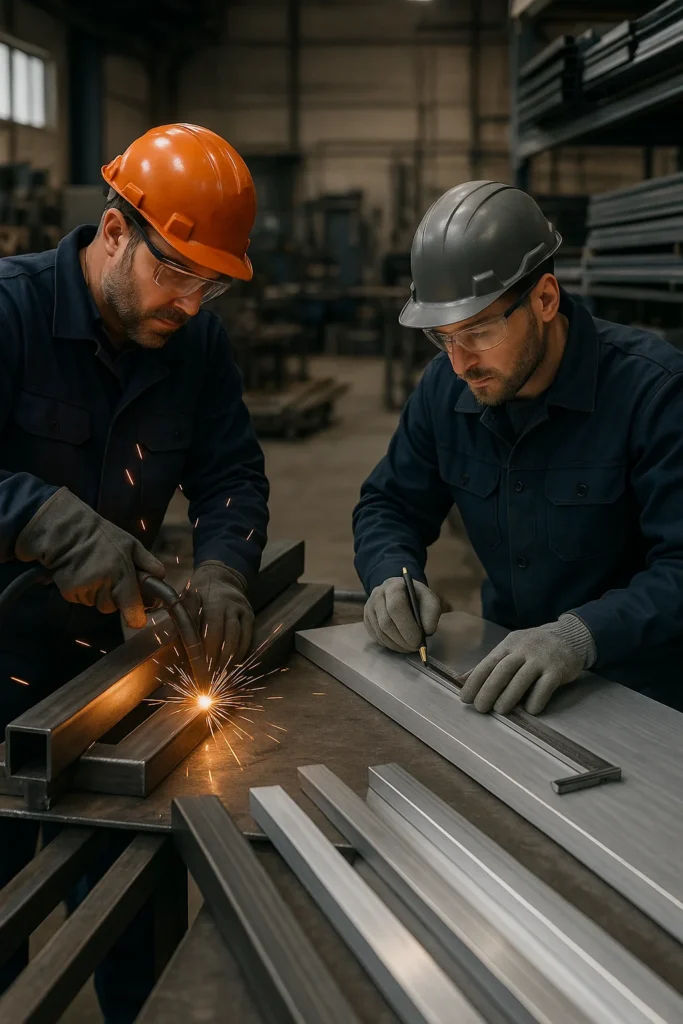
- Modern Fabrication Techniques in Oman
- Advantages of Local Fabrication Over Imports
- Sustainability and Recycling in the Omani Metal Industry
- Challenges Facing the Steel and Aluminium Market in Oman
- Future Trends in Steel and Aluminium Fabrication
- Top Steel and Aluminium Fabricators in Muscat
“Every great city stands on the strength of its foundations, and those foundations are often forged in steel and aluminium.” — Norman Foster, Architect
CONCLUSION
Steel and aluminium are two of the most essential materials in modern construction and fabrication, each offering unique benefits. Steel provides exceptional strength, durability, and load-bearing capacity, making it ideal for structural frameworks and heavy-duty applications. Aluminium, on the other hand, is lightweight, corrosion-resistant, and highly versatile, perfect for aesthetic designs and environments where weight reduction is critical. Choosing the right material—or a combination of both—depends on the specific project requirements. By leveraging their strengths, you can achieve structures and products that are strong, durable, and efficient.
What is steel and aluminium fabrication?
Steel and aluminium fabrication is the process of cutting, shaping, and assembling these metals into finished structures or products for industries such as construction, manufacturing, and energy.
Why is steel and aluminium fabrication important in Oman?
Oman’s rapid urban growth, industrial expansion, and infrastructure projects depend on strong, durable materials. Steel and aluminium meet these needs while supporting local economic growth.
Which industries in Muscat use steel and aluminium fabrication?
Key industries include construction, oil and gas, manufacturing, marine, transportation, and renewable energy projects.



